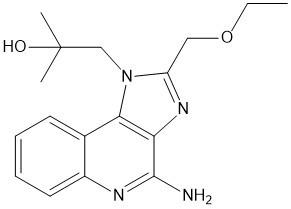Resiquimod | TLR7/8 agonist / Immune adjuvant
NMR (Conforms)

Available Options
| Size : | Price | Quantity | |
|---|---|---|---|
| 10 mM/1 mL DMSO | $65.00 | ||
| 10 mg | $65.00 | ||
| 50 mg | $260.00 |
Resiquimod (CAS 144875-48-9) is a Toll-like receptor 7/8 agonist.1 May be used as an immune adjuvant in cancer vaccines.2 Resiquimod-carrying synthetic vaccine particles augment the immune response to encapsulated antigen and exhibit strong local immune activation without inducing systemic cytokine release.3 Topical treatment of wild-type mice induces systemic autoimmune disease which may be used as a model of systemic Lupus erythematosus.4 It displayed potent antiviral activity (EC50 = 23.5 nM) in a murine norovirus replicon model.5
References/Citations
1) Jurk et al. (2002), Human TLR7 or TLR8 independently confer responsiveness to the antiviral compound R-848; Nat. Immunol., 3 499
2) Sabado et al. (2015), Resiquimod as an immunologic adjuvant for NY-ESO-1 protein vaccination in patients with high-risk melanoma; Cancer Immunol. Res., 3 278
3) Ilyinskii et al. (2014), Adjuvant-carrying synthetic vaccine particles augment the immune response to encapsulated antigen and exhibit strong local immune activation without inducing systemic cytokine release; Vaccine, 32 2882
4) Yokogawa et al. (2014), Epicutaneous application of toll-like receptor 7 agonists leads to systemic autoimmunity in wild-type mice: a new model of systemic Lupus erthematosus; Arthritis Rheumatol., 66 694
5) Tuipulotu et al. (2018), TLR7 Agonists Display Potent Antiviral Effects against Norovirus Infection via Innate Stimulation; Antimicrob. Agents Chemother., 62 e02417
NMR (Conforms)
Safety Data Sheet:
Product Data Sheet:
Materials provided by Focus Biomolecules are for laboratory research use only and are not intended for human or veterinary applications. Please note that we do not sell to individuals and that all orders placed by non-research organizations will incur a $20 restocking/refund fee
Resiquimod (CAS 144875-48-9) is a Toll-like receptor 7/8 agonist.1 May be used as an immune adjuvant in cancer vaccines.2 Resiquimod-carrying synthetic vaccine particles augment the immune response to encapsulated antigen and exhibit strong local immune activation without inducing systemic cytokine release.3 Topical treatment of wild-type mice induces systemic autoimmune disease which may be used as a model of systemic Lupus erythematosus.4 It displayed potent antiviral activity (EC50 = 23.5 nM) in a murine norovirus replicon model.5
References/Citations
1) Jurk et al. (2002), Human TLR7 or TLR8 independently confer responsiveness to the antiviral compound R-848; Nat. Immunol., 3 499
2) Sabado et al. (2015), Resiquimod as an immunologic adjuvant for NY-ESO-1 protein vaccination in patients with high-risk melanoma; Cancer Immunol. Res., 3 278
3) Ilyinskii et al. (2014), Adjuvant-carrying synthetic vaccine particles augment the immune response to encapsulated antigen and exhibit strong local immune activation without inducing systemic cytokine release; Vaccine, 32 2882
4) Yokogawa et al. (2014), Epicutaneous application of toll-like receptor 7 agonists leads to systemic autoimmunity in wild-type mice: a new model of systemic Lupus erthematosus; Arthritis Rheumatol., 66 694
5) Tuipulotu et al. (2018), TLR7 Agonists Display Potent Antiviral Effects against Norovirus Infection via Innate Stimulation; Antimicrob. Agents Chemother., 62 e02417
Calculate the molar concentration, mass or volume in a solution.
Concentration × Volume × Molecular Weight = Mass
Focus Biomolecules • Plymouth Meeting, PA USA • 1-855-FOCUS21
Focus Biomolecules
Plymouth Meeting, PA USA
1-855-FOCUS21
Website Created by Advanta Advertising LLC.

